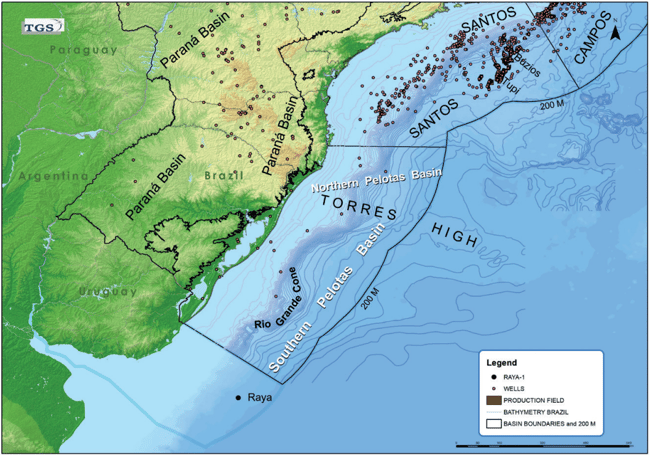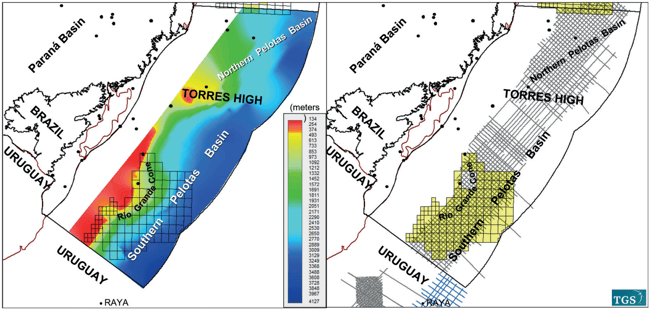First Published: First Break, November 2022
Pedro V. Zalan*, Randall Etherington and Milos Cvetovic demonstrates how the same source rocks from the African side of the South Atlantic show the potential for petroleum systems in the South American side of the southern South Atlantic.
Introduction
Following the discovery of two vast fields of gas/condensate in South Africa (Brulpadda with 2.1 TCF/112 MMbc, Luiperd 1.3 TCF/80 MMbc) and, more recently, of oil/gas in Namibia (Graff, 700 MMbor, and Venus, with rumoured recoverable resources ~13.4 billion boe) a new proven petroleum system was established in the southern South Atlantic. These discoveries share the same source rock of Aptian anoxic marine shales and reservoirs in Cretaceous turbidites deposited as channels and lobes (Hedley et al, 2022; Winter et al, 2022). The trapping mechanism is purely stratigraphic (lateral and updip pinch outs) and the tectono-stratigraphic environment of their occurrence is the basal portions of mostly undisturbed siliciclastic Drift Sequences resting upon Seaward-Dipping Reflectors (SDRs) or oceanic crust. This petroleum system was already known to be highly productive in the Equatorial Atlantic Ocean (Guyana/ Suriname and Ghana/Ivory Coast) and in the northern parts of the South Atlantic Ocean (Sergipe-Alagoas, Equatorial Guinea, Angola, Espirito Santo/Campos/Santos). Its occurrence in more austral latitudes with such effectiveness and richness was a surprise to the petroleum industry. Therefore, it was a natural next step for the oil companies to look across the ocean and focus their attention on the homologous margins of southern Brazil, Uruguay, and Argentina.
 Figure 1 Situation map for Pelotas Basin in southern Brazil. The Torres High divides the basin into two
Figure 1 Situation map for Pelotas Basin in southern Brazil. The Torres High divides the basin into two
sub-basins: Northern Pelotas and Southern Pelotas. Nine wells were drilled in the basin. The Raya well in
Uruguay is also displayed for further referencing. The Rio Grande Cone is an important depositional feature
in the Southern Pelotas Basin.
This successful petroleum system is named the Cretaceous Marine Anoxic Shales-Late Cretaceous Turbidites (!). The
source rocks are marine anoxic shales of Aptian/Turonian ages, of which the Aptian shale seems to be the richest and most effective contributor. The reservoirs are Late Cretaceous turbidites deposited in large basin floor submarine fans fed by channelized systems. The traps are primarily of stratigraphic nature, being the superposition of the reservoir upon the source rock the optimum geometric relationship. In three of the four discoveries cited above, the reservoirs are of Aptian age and rest upon the Aptian organic-rich shale. This system is ubiquitous in the continental margins of the South Atlantic Ocean. The only variation among these different basins is the age of the primary contributing source
rock, sometimes Turonian/Cenomanian (Equatorial Atlantic), sometimes Albian (northern South Atlantic), and sometimes
Aptian (southern South Atlantic).
 Figure 2 Left: Bathymetry of the Pelotas Basin and blocks offered in the Permanent Offer mode in the Southern Pelotas Basin.
Figure 2 Left: Bathymetry of the Pelotas Basin and blocks offered in the Permanent Offer mode in the Southern Pelotas Basin.
The influence of the Rio Grande Cone is exerted upon 1/3 of the blocks offered. Only three wells were drilled in water depths greater
than 400 m. Right: Seismic data available from TGS. Most of the blocks are covered by a regular 10 km X 10 km grid.
The time has now come to prove the presence and effectiveness of these source rocks in the South American side of the southern South Atlantic. The Greater Pelotas Basin is comprised of a single, uninterrupted, enormous offshore sag basin, extending from Southern Brazil, through Uruguay, to northern Argentina. It contains large thicknesses of Lower and Upper Cretaceous to Cenozoic Drift Sequences, resting upon volcanic substratum (either Seaward Dipping Reflectors (SDRs) or Oceanic Crust). It is the quintessence of a Volcanic Passive Margin. Ten wells nine in Brazil and one in Uruguay) have been drilled in this frontier area, and only three of them are in deep/ultra-deep water (Figures 1 and 2). In this article, we will be dealing only with the Brazilian portion of the Greater Pelotas Basin because....
<continued>
Download the full article using the link at the top of the page.

